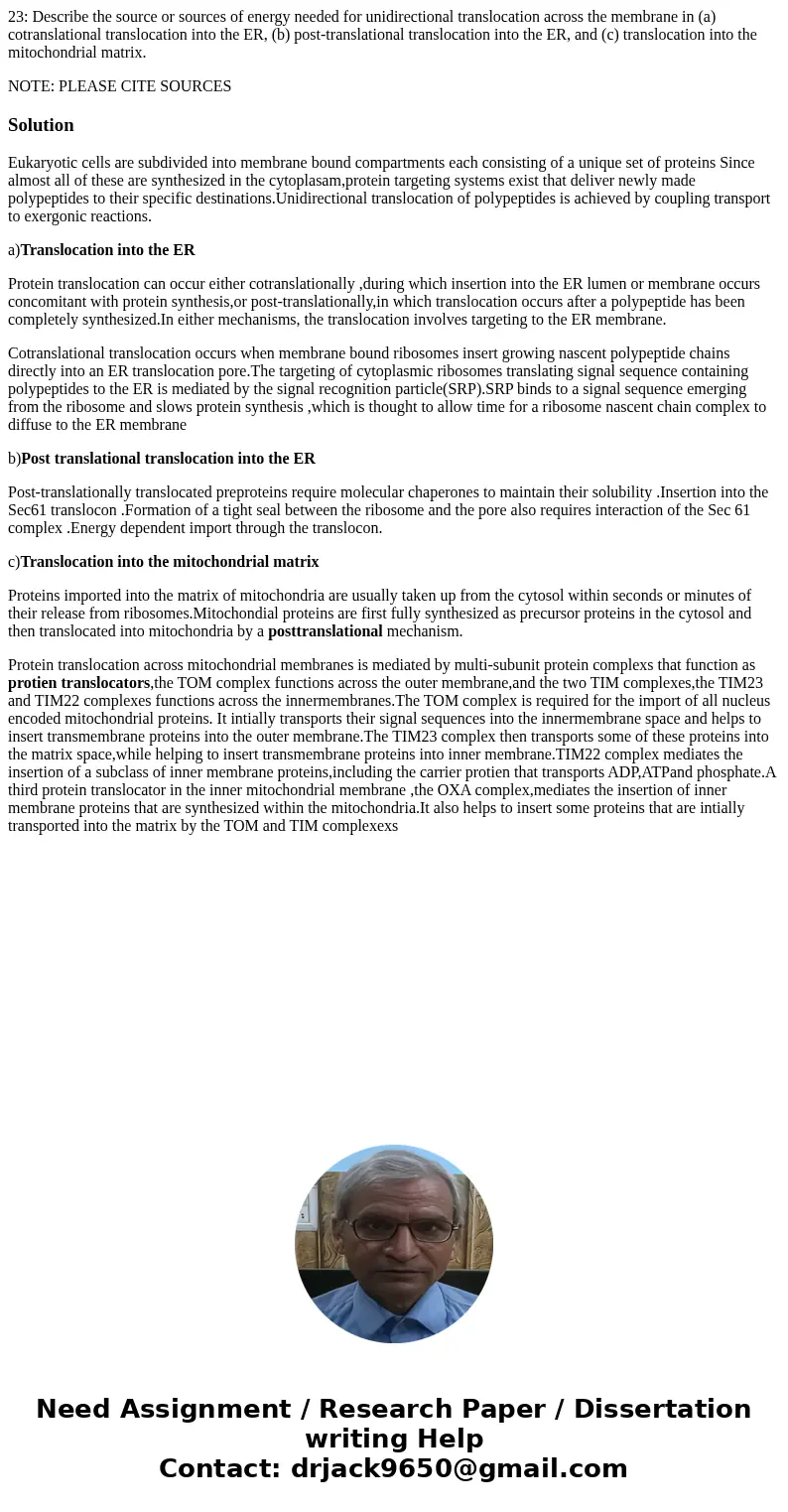23 Describe the source or sources of energy needed for unidi
23: Describe the source or sources of energy needed for unidirectional translocation across the membrane in (a) cotranslational translocation into the ER, (b) post-translational translocation into the ER, and (c) translocation into the mitochondrial matrix.
NOTE: PLEASE CITE SOURCES
Solution
Eukaryotic cells are subdivided into membrane bound compartments each consisting of a unique set of proteins Since almost all of these are synthesized in the cytoplasam,protein targeting systems exist that deliver newly made polypeptides to their specific destinations.Unidirectional translocation of polypeptides is achieved by coupling transport to exergonic reactions.
a)Translocation into the ER
Protein translocation can occur either cotranslationally ,during which insertion into the ER lumen or membrane occurs concomitant with protein synthesis,or post-translationally,in which translocation occurs after a polypeptide has been completely synthesized.In either mechanisms, the translocation involves targeting to the ER membrane.
Cotranslational translocation occurs when membrane bound ribosomes insert growing nascent polypeptide chains directly into an ER translocation pore.The targeting of cytoplasmic ribosomes translating signal sequence containing polypeptides to the ER is mediated by the signal recognition particle(SRP).SRP binds to a signal sequence emerging from the ribosome and slows protein synthesis ,which is thought to allow time for a ribosome nascent chain complex to diffuse to the ER membrane
b)Post translational translocation into the ER
Post-translationally translocated preproteins require molecular chaperones to maintain their solubility .Insertion into the Sec61 translocon .Formation of a tight seal between the ribosome and the pore also requires interaction of the Sec 61 complex .Energy dependent import through the translocon.
c)Translocation into the mitochondrial matrix
Proteins imported into the matrix of mitochondria are usually taken up from the cytosol within seconds or minutes of their release from ribosomes.Mitochondial proteins are first fully synthesized as precursor proteins in the cytosol and then translocated into mitochondria by a posttranslational mechanism.
Protein translocation across mitochondrial membranes is mediated by multi-subunit protein complexs that function as protien translocators,the TOM complex functions across the outer membrane,and the two TIM complexes,the TIM23 and TIM22 complexes functions across the innermembranes.The TOM complex is required for the import of all nucleus encoded mitochondrial proteins. It intially transports their signal sequences into the innermembrane space and helps to insert transmembrane proteins into the outer membrane.The TIM23 complex then transports some of these proteins into the matrix space,while helping to insert transmembrane proteins into inner membrane.TIM22 complex mediates the insertion of a subclass of inner membrane proteins,including the carrier protien that transports ADP,ATPand phosphate.A third protein translocator in the inner mitochondrial membrane ,the OXA complex,mediates the insertion of inner membrane proteins that are synthesized within the mitochondria.It also helps to insert some proteins that are intially transported into the matrix by the TOM and TIM complexexs

 Homework Sourse
Homework Sourse